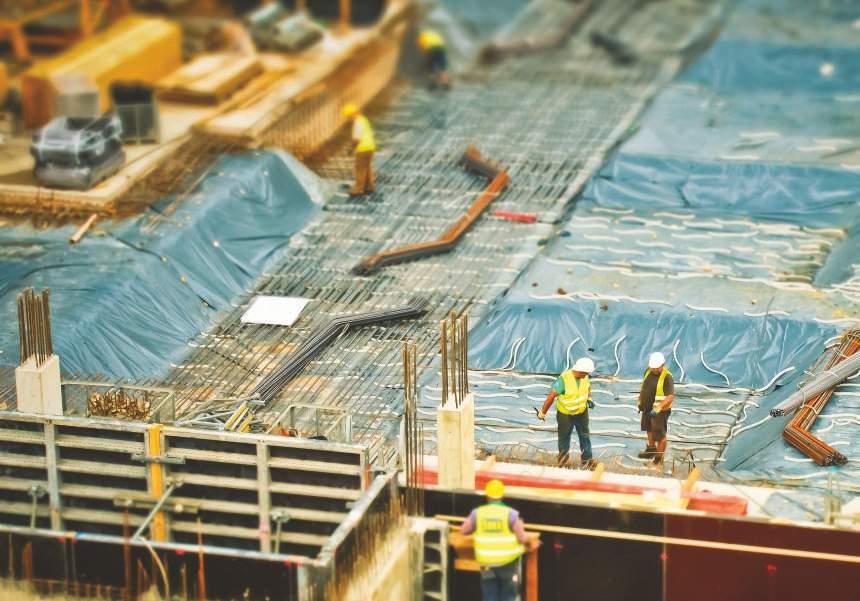
9 minute read
Construction 2020: Looking ahead with optimism
The construction sector in India has had its ups and downs and the road ahead needs to be threaded with caution and discipline
Construction is one of largest employer in India after agriculture. An array of industries such as cement, steel, brick, timber and building material make up the construction sector and as we step into the new year key concerns remain, concerns about how the sector is poised and how will it perform in the existing business climate.
Advertisement
Market realities The construction sector encompasses a lot of ancillary industries and to sustain the momentum of growth in the sector, the individual issues of these industries need to be looked at too.
“It is true that there has been a slow down, in fact the Indian construction sector alone can’t be blamed since the whole world is facing a slowdown, it is a recession of sorts. In comparison to the previous year there has been a slowdown worth 30-40 per cent,” says Manikandan Mahalingam, General Director, Paschal Formwork (India) Private Limited, one of the leading formwork suppliers in India “The sector is in need of a cash flow and that remains a big concern, so if the cash flow is structured and the infrastructure projects are executed timely, there is no reason the Indian construction should not rebound and witness a gradual and steady growth in 2020-21.”
Rakesh Modi, Chairman, Mtandt Group, a pioneer in bringing aerial work platform, mobile access platforms and fixed fall protection in the Indian markets says “Government also needs to support manufacturing by incentivising the exports and providing the infrastructure on rent. Today If I want to put up a factory 50 per cent of my investment goes up in buying the land and setting up the manufacturing facility and associated infrastructure. Should I prefer to invest this money on acquiring the raw material or any other factor I feel is of importance, there is no way out. In China and other developed nations the government makes production facilities available to entrepreneurs on rent, one can just go and start production. A similar program in India will go a long way in encouraging potential entrepreneurs too.”
Maintaining the momentum of growth According to Nejeeb Khan, Head Design and Business Strategy in India, Katerra “In the past, government initiatives such as 100 smart cities, world-class highways, and shipping infrastructure, housing, and urban development have attracted significant investments through FDI, private players, and government budgets. As per the economic survey 2017-18, India will require US $4.5 trillion by 2040 for the development of infrastructure. Thus, looking forward to 2020 and beyond, we believe the construction sector will find itself at the center of rapid economic and social change, which is already transforming the built environment.”
Residential and commercial construction and infrastructure projects like roads, railways, airports and ports are some of the key areas which have been under the government’s radar. In fact during December 2018, as a report by IBEF points out, the infrastructure sector witnessed PE/VC twelve deals worth 500 million and eight `6,989 crore (US$ 1 billion) plus deals.

PE/ VC investments for infrastructure touched an all-time high of US$ 36.7 billion during January-August 2019.
The government is keen to ensure that the momentum of growth in the sector remains upbeat. In January 2019, the government outlined the investments under the second phase of Bharatmala scheme. According to Research and Markets, this initiative will drive the road infrastructure developments in the country. Accordingly, the government also aims to invest `3.4 trillion (US$50.3 billion) through the budgetary allocation between FY2019-2020 and FY2022- 2023, while `2.1 trillion (US$30.7 billion) will be made through market borrowings in the Bharatmala scheme by 2023.
Likewise, population growth and urbanisation will also drive the need for better infrastructure facilities in the country. The need for affordable housing is also likely to prep up the construction sector too. The Housing for All scheme aims to create 20 million affordable houses for the urban poor by 2022. It will provide a boost to the residential construction which is experiencing sluggish growth owing to rising price of land banks and unsold inventories.
Monetising the built environment It goes without saying that roads and highways play an important role in the nation’s economy and keeping that in mind the government had proposed the Bharatmala Pariyojana. A flagship highway development programme of Government of India it encompasses development of
Manikandan Mahalingam, General Director, Paschal Formwork (India) Private Limited If the cash flow is structured and the infrastructure projects are executed timely, there is no reason why the Indian construction sector should not rebound and witness a gradual and steady growth in 2020-21.
Rakesh Modi, Chairman, Mtandt Group In China and other developed nations the government makes production facilities available to entrepreneurs on rent, one can just go and start production. A similar program in India will go a long way in encouraging potential entrepreneurs too.
24,800 km of roads for a total investment of `5,35,000 crore.

When the plan itself is so ambitious it is equally essential to monetise it. Hence last month, the union cabinet, chaired by the Prime Minister Narendra Modi, has given its approval to the proposal of Ministry of Road Transport and Highways, authorizing National Highways Authority of India (NHAI) to set up Infrastructure Investment Trust(s) (InvIT) as per InvIT Guidelines issued by SEBI. This will enable NHAI to monetise completed National Highways that have a toll collection track record of at least one year and NHAI reserves the right to levy toll on the identified highway. This will enable NHAI to generate adequate funds to complete pending projects within the prescribed timelines. The government is also keen offer attractive schemes to private players to invest in construction of National Highways.
Paul Wallett, Regional Director, Middle East and India, Trimble Solutions The importance of lean construction methodologies, the adoption of technology enabled construction practices can provide a major boost to construction sector.
The role of technology in construction According to Nejeeb Khan, Head Design and Business Strategy in India, Katerra points out “The Indian construction sector, traditionally, has been quite slow in adopting new technologies, and this has been one of its biggest challenges. Several surveys show how, over the years, real estate developers have continued to under invest in technologydriven solutions for construction, despite acknowledging the many benefits that these solutions can provide to run and manage their construction projects.”
The World Economic Forum too ascertains the role of technology in infrastructure development. It also points out certain issues in the procurement area if addressed can enhance the quality and efficiency in construction. Incorporating technology to get it right
“The importance of lean construction methodologies, the adoption of technology enabled construction practices can provide a major boost to construction sector,” says Paul Wallett, Regional Director, Middle East and India, Trimble Solutions. “Using the right mix of hardware, software and mobility technologies from leading construction technology players like Trimble can help the construction sector streamline communication, collaboration and project execution across the construction continuum. Connecting people, machines and projects deliver real time data to infrastructure owners, architects, engineers, civil contractors, and each stakeholder for enhanced information about material, people and asset utilization, thus resulting in improved productivity and profitability.”
The implementation of technology Infrastructure developers, as a report by the World Economic Forum points out, face a dilemma in bridging the gap between the technological advances that can modernise infrastructure at all stages and the status quo of current infrastructure development practices.
Infrastructure delivery is already benefiting tangentially from technological advances. AI tools are reorganising how traffic flows are measured and managed, and the demand for smart and smarter cities rightly dominates discussions about infrastructure technology priorities. In construction, technological advances can shorten completion times and lower costs, providing muchneeded efficiency in project delivery.
(a)The procurement angle These innovations, however, are primarily in the domains of urban planners and the engineering and construction industries. Core infrastructure will remain structurally resistant to the potentially dramatic benefits of technology unless the entire infrastructure procurement cycle is radically altered. Procurement is the core of the infrastructure community; it starts when planners finish and ends just before construction professionals take over. Procurement primarily revolves around finance – no blueprint can become a building without capital. This narrow yet critical space remains resistant to the technological revolution; indeed, it remains in the dark ages.
How can infrastructure finance become the door through which disruptively creative forces enter? First, consider how infrastructure is financed. Generally the financing comes directly out of the public coffers, whether with current or borrowed capital or with private capital in some version of what is usually called a public-private partnership (PPP). This financial underpinning, which is largely one of debt over equity, is quite the opposite of the financial underpinnings of disruptive technological innovation, which prizes equity over debt. A publicly financed project is likely to be little more than a construction project unless the government has invested in an incubator of technological solutions, which is an unlikely scenario.
A PPP should be the model that allows technology entrepreneurs to unleash innovative forces. Sadly, this is not the case.
(b)Creating new procurement models Creating new procurement models will require wholesale changes in the laws, regulations and cultures of the procurement agencies in most countries. Nevertheless, unless agencies undertake this kind of full upending of infrastructure procurement, infrastructure will continue to lag behind the rest of the economy in reaping the benefits of the Fourth Industrial Revolution. Every procurement does not need to be revised, however, for technology’s innovative power to reform infrastructure development. Rather, this is more likely to occur in selected pilot programmes that demonstrate new pathways forward. As many countries face economic governance and capacity issues, these projects are likely to be first piloted in countries with strong economic governance and later replicated around the world. Some will undoubtedly fail, as with any attempt at changing a staid status quo. This effort, however, can lead to new approaches in delivering solutions that current systems prevent and can bring about the digitally transformed infrastructure systems so badly needed around the world.
Ar. Dikshu Kukreja goes one-on-one with Ar. Patrik Schumacher
The highlight at the Foaid 2019 saw Dikshu Kukreja and Patrik Schumacher engage in a one-on-one conversation about responsibly reshaping future cities. The stalwarts also brought to forefront, the urgent requirement of reformed public policies and tactical urbanism which can contribute to a fast paced changemaking.

The Foaid event had the who’s who of architectural fraternity in attendance. The highlight of the event, however, remained the oneon-one conversation between the Managing Principal of CP Kukreja

Architects, Dikshu Kukreja with the Principal of the world-renowned Zaha Hadid Architects, Patrik Schumacher. The much awaited session saw a harmonious confluence of the East and West architectural ideologies. The two stalwarts engaged in an enthralling discourse revolving around responsibly reshaping future cities bringing to the forefront, aspects such as climate change and its effect on city planning, the importance and power of community participation in change-making and how responsible political involvement in architecture and planning can go a long way in benefitting the inhabitants of cities.










